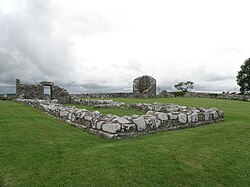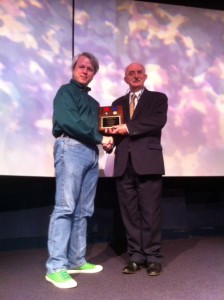Here at the foot of the Vosges mountains, close by a healing stream, there arose the great Community of Luxeuil. Although the site had been completely deserted and overgrown, this exactly suited Columbanus, for he loved manual labour as much as he loved solitude. So great did it become that the most noble youths of the Franks asked to be admitted to its brotherhood. As they grew in holiness so they grew in happiness for surely the blessing of God was upon them and as their community increased it was necessary to make a third foundation at Fontaine, three miles north of Luxeuil.
The Community of Columbanus grew so large that it was necessary for the three centres to have a written Rule. The Abbot therefore composed for them a Regula Monachorum or ‘Rule of the Monks’, which was an exposition of the basic principles of monasticism. The central discipline of this was obedience. There can be little doubt that the early chapters are a summary of the Good Rule of Bangor written by Comgall himself. As well as this, Columbanus wrote a Regula Coenobialis or ‘Community Rule’ which lists the punishments to be meted out for any breaches of the discipline of the Rule.
The form in which it exists today probably contains later additions by Columbanus’s successors in Luxeuil but the opening section must go back to Columbanus himself. For the lay and clerical penitents who came to Luxeuil Columbanus wrote a further Penitental. This, too, was probably a Bangor conscription and shows great similarities to that of Finnian (British Uinnian) of Movilla. Atonement for sin required the practice of the opposite virtue. “The talkative is to be punished with silence, the restless with the practice of gentleness, the gluttonous with fasting, the sleepy with watching, the proud with imprisonment, the deserter with expulsion.”
Dr J. F. Kenney has written that the Rule of Columbanus forms a ‘Mirror of Perfection’ for those who were intent on pursuing the religious life. “Acceptance with unflinching logic of the precepts of Christ as preserved in the New Testament is its essential characteristic. A severity seemingly greater than human nature could endure results; absolute obedience to the will of the senior; heavy and unremitting toil, mortification of the flesh to a degree that might be expected to impair the physical strength, are some of its impositions.”
It is the only monastic rule of Irish origin, written in the Latin language, which still survives, and it is the earliest and most informative of all the rules which can be regarded as Irish. Luxeuil quickly became the Mother House of the three Communities and the most celebrated, and classical studies were of the utmost importance. The art of music was prominent as in Bangor and was taught at a level at that time unknown in Europe. H. Zimmer has written,
“They were the instructors in every branch of science and learning of the time, possessors and bearers of a higher culture than was at that time to be found anywhere on the Continent, and can surely claim to have been the pioneers – to have laid the cornerstone of western culture on the Continent.”
In 597 Columba of the “Ui Neill” died on the island of Iona and in 603 Comgall of the Cruthin, whose Patron had been the beautiful Cantigern, Queen of Dalaradia, died at his monastery in Bangor, in the ninety-first year of his age, in the fiftieth year and third month and tenth day of his presidency, on the sixth of the Ides of May… And of Comgall they wrote in the Bangor Antiphonary:
Amavit Christus Comgillum, Christ loved Comgall
Bene et ipse Dominum, Well, too, did he the Lord.
To be continued
© Pretani Associates 2014

 Marcel Kittel wins Stage Two. Pic: BBC.
Marcel Kittel wins Stage Two. Pic: BBC. And no wonder because the arrival of the Giro signified another stage passed in the Belfast’s miraculous journey from war to peace.
And no wonder because the arrival of the Giro signified another stage passed in the Belfast’s miraculous journey from war to peace. 






